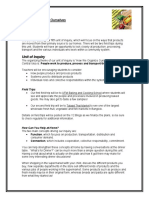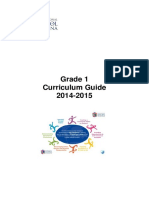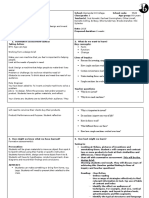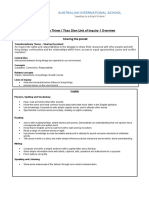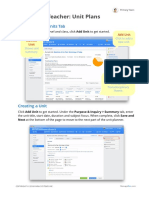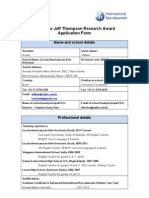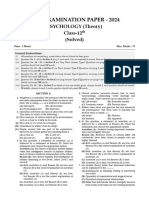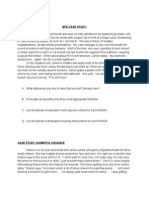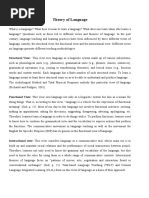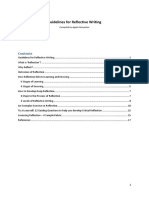PYP Language Rubric Draft
PYP Language Rubric Draft
Uploaded by
rodickwh7080Copyright:
Available Formats
PYP Language Rubric Draft
PYP Language Rubric Draft
Uploaded by
rodickwh7080Copyright
Available Formats
Share this document
Did you find this document useful?
Is this content inappropriate?
Copyright:
Available Formats
PYP Language Rubric Draft
PYP Language Rubric Draft
Uploaded by
rodickwh7080Copyright:
Available Formats
Language Criterion A: Oral Language
Achievement Level NO Phase 1-Phase 2 Level Descriptor The student has not been observed in this criterion for this unit. The student recognizes that sounds are associated with objects, or with symbolic representations of them. The student is using language to name his or her environment, to get to know others, to initiate and explore relationships, to question and inquire. The student is aware that an object or symbol may have different sounds or words associated with it in different languages. He or she is beginning to be cognizant about the high degree of variability of language and its uses. The learner shows an understanding of the wide range of purposes of spoken language: that it instructs, informs, entertains, reassures; that each listeners perception of what he or she hear is unique. He or she is compiling rules about the use of different aspects of language. The learner shows an understanding of the conventions associated with speaking and listening and the value of adhering to those conventions. He or she is aware that language is a vehicle for becoming knowledgeable; for negotiating understanding; and for negotiating the social dimension. The learner is able to understand the difference between literal and figurative language; how to use language differently for different purposes. He or she is aware that he or she is building on previous experiences and using language to construct new meaning. Related Student Performance
Phase 3-Phase 4
Phase 5-Phase 6
Phase 7-Phase 8
Phase 9-Phase 10
Language Criterion B: Visual Language
Achievement Level NO Phase 1-Phase 2 Level Descriptor The student has not been observed in this criterion for this unit. The student is able to interpret and respond to visual texts. He or she is extending and using visual language in more purposeful ways. The student identifies, interprets and responds to a range of visual text prompts and shows an understanding that different types of visual texts serve different purposes. He or she uses this knowledge to create his or her own visual texts for particular purposes. The learner shows an understanding that visual text may represent reality or fantasy. He or she recognizes that visual text resources can provide factual information and increase understanding. He or she uses visual text in a reflective way to enrich his or her storytelling or presentations, and to organize and represent information. The learner shows open-mindedness about the use of a range of visual text resources to access information. He or she thinks critically, and is articulate about the use of visual text Related Student Performance
Phase 3-Phase 4
Phase 5-Phase 6
Phase 7-Phase 8
Phase 9-Phase 10
to influence the viewer. He or she is able to use visual imagery to present factual information, or to tell a story. Through inquiry, the learner engages with an increasing range of visual text resources. As well as exploring the viewing and presenting strategies that are a part of the planned learning environment, he or she selects and uses strategies that suit his or her learning style. He or she is able to make connections between visual imagery and social commentary. He or she shows more discernment in selecting information considered reliable. He or she is able to use visual imagery to support a position.
Language Criterion C: Written Language (Reading)
Achievement Level NO Phase 1-Phase 2 Level Descriptor The student has not been observed in this criterion for this unit. The learner shows an understanding that print represents the real or the imagined world. He or she knows that reading gives knowledge and pleasure; that it can be a social activity or an individual activity. He or she has a concept of a book, and an awareness of some of its structural elements. He or she uses visual cues to recall sounds and the words he or she is reading to construct meaning. The learner shows an understanding that language can be represented visually through codes and symbols. He or she is extending his or her data bank of printed codes and symbols and is able to recognize them in new contexts. He or she understands that reading is a vehicle for learning, and that the combination of codes conveys meaning. The learner shows an understanding that text is used to convey meaning in different ways and for different purposes he or she is developing an awareness of context. He or she uses strategies, based on what he or she knows, to read for understanding. He or she recognizes that the structure and organization of text conveys meaning. The learner shows an understanding of the relationship between reading, thinking, and reflection. He or she knows that reading is extending their world, both real and imagined, and that there is a reciprocal relationship between the two. Most importantly, he or she has established reading routines and relishes the process of reading. The learner shows an understanding of the strategies authors use to engage them. He or she has favourite authors and can articulate reasons for such choices. Reading provides a sense of accomplishment, not only in the process, but also in the access it provides to further knowledge about, and understanding of, the world. Related Student Performance
Phase 3-Phase 4
Phase 5-Phase 6
Phase 7-Phase 8
Phase 9-Phase 10
Language Criterion D: Written Language (Writing)
Achievement Level NO Phase 1-Phase 2 Level Descriptor The student has not been observed in this criterion for this unit. The learner shows an understanding that writing is a form of expression to be enjoyed. He or she knows that how you Related Student Performance
Phase 3-Phase 4
Phase 5-Phase 6
Phase 7-Phase 8
Phase 9-Phase 10
write and what you write conveys meaning; that writing is a purposeful act, with both individual and collaborative aspects. The learner shows an understanding that writing is a means of recording, remembering and communicating. He or she knows that writing involves the use of codes and symbols to convey meaning to others; that writing and reading uses the same codes and symbols. He or she knows that writing can describe the factual or the imagined world. The learner shows an understanding that writing can be structured in different ways to express different purposes. He or she uses imagery in stories to enhance the meaning and to make it more enjoyable to write and read. He or she understands that writing can produce a variety of responses from readers. He or she can tell a story and create characters in writing. The learner shows an understanding of the role of the author and is able to take on the responsibilities of authorship. He or she demonstrates an understanding of story structure and is able to make critical judgments about individual writing, and the writing of others. He or she is able to rewrite to improve the quality of writing. The learner shows an understanding of the conventions pertaining to writing, in its different forms, that are widely accepted. In addition, he or she demonstrates a high level of integration of the strands of language in order to create meaning in a manner that suits his or her learning styles. He or she can analyze the writing of others and identify common or recurring themes or issues. He or she accepts feedback from others.
You might also like
- Different Definition and Characteristics of Reading100% (4)Different Definition and Characteristics of Reading6 pages
- How The World Works - Unit Letter 4 - FinalNo ratings yetHow The World Works - Unit Letter 4 - Final6 pages
- G2 How We Express Ourselves Unit OverviewNo ratings yetG2 How We Express Ourselves Unit Overview3 pages
- How We Organize Ourselves Parent Letter 2011No ratings yetHow We Organize Ourselves Parent Letter 20112 pages
- ManageBac User Group Conference Munich: ProgrammeNo ratings yetManageBac User Group Conference Munich: Programme16 pages
- Ela100 3 3 Word Choice Writing LessonideasNo ratings yetEla100 3 3 Word Choice Writing Lessonideas3 pages
- Concept Based Teaching and Learning PPTNo ratings yetConcept Based Teaching and Learning PPT10 pages
- S2 English Scope and Sequence ChecklistNo ratings yetS2 English Scope and Sequence Checklist17 pages
- Express It!: 1 Grade Visual Art CurriculumNo ratings yetExpress It!: 1 Grade Visual Art Curriculum31 pages
- Myp 5 Grade 10 Horizontal Navrachana 5 Horizontal Sgopdf Lang Acquisition100% (1)Myp 5 Grade 10 Horizontal Navrachana 5 Horizontal Sgopdf Lang Acquisition36 pages
- Pyp Collaborative Planning Workshop Workbook Cistokyo Oct2013100% (1)Pyp Collaborative Planning Workshop Workbook Cistokyo Oct201385 pages
- 9 Stage Planner Gr4 How We Organise OurselvesNo ratings yet9 Stage Planner Gr4 How We Organise Ourselves4 pages
- IB Unit Planning For 2018-19 Sara Collins Elementary School: KindergartenNo ratings yetIB Unit Planning For 2018-19 Sara Collins Elementary School: Kindergarten12 pages
- Day/Hour 1 Day/Hour 2 Day/Hour 3 Day/Hour 4 Day/Hour 5: CalendarNo ratings yetDay/Hour 1 Day/Hour 2 Day/Hour 3 Day/Hour 4 Day/Hour 5: Calendar2 pages
- World-Readiness Standards (General) + Language-specific document (CHINESE)From EverandWorld-Readiness Standards (General) + Language-specific document (CHINESE)No ratings yet
- Equal Rights to the Curriculum: Many Languages, One MessageFrom EverandEqual Rights to the Curriculum: Many Languages, One MessageNo ratings yet
- Reading Comprehension Intervention StrategiesNo ratings yetReading Comprehension Intervention Strategies18 pages
- Directed Reading Thinking Activity Strategy Checklist100% (1)Directed Reading Thinking Activity Strategy Checklist4 pages
- SG Personality Didsafdasorders Survivors of Violence Fall 2014No ratings yetSG Personality Didsafdasorders Survivors of Violence Fall 20142 pages
- A Biopsychosocial Investigation of Changes in Self-Concept On The Head Injury Semantic Differential ScaleNo ratings yetA Biopsychosocial Investigation of Changes in Self-Concept On The Head Injury Semantic Differential Scale22 pages
- Impact of Working Environment On Job SatisfactionNo ratings yetImpact of Working Environment On Job Satisfaction5 pages
- "Just Talk To Me": Day 5: Vulnerability & Meta-Communication Relational HomeworkNo ratings yet"Just Talk To Me": Day 5: Vulnerability & Meta-Communication Relational Homework4 pages
- Innovation and Creativity in Education and TraininNo ratings yetInnovation and Creativity in Education and Trainin65 pages
- (Wisconsin Studies in Autobiography) Anna Poletti - Julie Rak - Identity Technologies - Constructing The Self Online (2014, University of Wisconsin Press)No ratings yet(Wisconsin Studies in Autobiography) Anna Poletti - Julie Rak - Identity Technologies - Constructing The Self Online (2014, University of Wisconsin Press)301 pages
- Guidelines For Reflective Writing: Compiled by Agata MouasherNo ratings yetGuidelines For Reflective Writing: Compiled by Agata Mouasher17 pages
- "Don't Go With Stranger": A Social Study On Child's Vigilance To A StrangerNo ratings yet"Don't Go With Stranger": A Social Study On Child's Vigilance To A Stranger10 pages
- Education in Malaysia A Statement of The Baha I Community of MalaysiaNo ratings yetEducation in Malaysia A Statement of The Baha I Community of Malaysia13 pages
- Occidental Mindoro State College: Republic of The Philippine100% (1)Occidental Mindoro State College: Republic of The Philippine3 pages
- Studi Perilaku Organisasional: Perspektif Dan Analisis Perilaku Individu Di Dalam OrganisasiNo ratings yetStudi Perilaku Organisasional: Perspektif Dan Analisis Perilaku Individu Di Dalam Organisasi33 pages
- Closer To Me - A Literary Analysis of E.E. Cummings' Poem Entitled May I Feel Said HeNo ratings yetCloser To Me - A Literary Analysis of E.E. Cummings' Poem Entitled May I Feel Said He3 pages




















